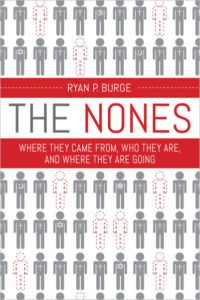Growing up in Texas during the Southern Baptist Iron Age, I learned this bit of gospel doggerel somewhere between Sunday School, Vacation Bible School or Romper Room (Google it) and the hand-signals that accompanied it:
Here is the church,
Here is the steeple,
Open the doors,
And there are the people.

Bill Leonard
Decades later, we’ve still got the churches and their steeples pointing heavenward, but where are the people? This month the Gallup organization reported that for the first time since they started polling in 1937, fewer than 50% of Americans claim membership is churches, mosques or synagogues. Sociologists have tracked these burgeoning declines for several decades, with attrition that runs from 70% claiming membership in the 1990s, to 50% in 2019, to 47% in 2021 (with no plateau in sight).
In Gallup’s study, these fissures in religious participation seem evident among every American demographic age group, including “traditionalists,” born before 1945, down from 73% to 66%; “Baby Boomers,” dropping from 63% to 58%; Generation X, from 57% to 50%; and “Millennials” from 51% to 35%, as indicated in 2020 studies.
Look at the Millennials
Statistics regarding Millennials may be the most daunting of all, particularly in terms of the future of American religious communities. A recent American Enterprise Institute study suggests that persons in this population segment “are now almost as likely to say they have no religion as they are to identify as Christian.” One in four Millennials claim no religious affiliation. The study contends that:
- Numerous Millennials did not grow up with close connections to formal religious bodies and thus have few ties that encourage return to faith communities in later life.
- “Changing views about the relationship between morality and religion also appear to have convinced many young parents that religious institutions are simply irrelevant or unnecessary for their children.”
- Over half the Millennials participating in this study agreed that “religious people are less tolerant than non-religious people.”
- The lack of formal religiosity among Millennials is due in part to the fact that many of their parents “were more likely than previous generations to raise their children without any connection to organized religion.” To illustrate, only 32% of Millennials claimed that, during their childhood, their family participated in religious services. Forty-nine percent of Baby Boomers made that claim. And now, 57% of Millennials view religion as important to rearing their own children, as opposed to 75% of Baby Boomers.
Look at the ‘nones’
And then there are the “nones,” those who attest to no distinct affiliation with any religious group. I have written about them frequently in this space, but as “nones” continue to expand throughout American society, so do studies about them.
 A recent and intriguing investigation comes from Ryan Burge, ordained Baptist minister and assistant professor of political science at Eastern Illinois University. His new book, The Nones: Where They Came from, Who They Are, and Where They Are Going, was featured in a March 24 article by Religion News Service reporter Jana Reiss as well as an April 11 BNG article by Jeff Brumley.
A recent and intriguing investigation comes from Ryan Burge, ordained Baptist minister and assistant professor of political science at Eastern Illinois University. His new book, The Nones: Where They Came from, Who They Are, and Where They Are Going, was featured in a March 24 article by Religion News Service reporter Jana Reiss as well as an April 11 BNG article by Jeff Brumley.
In the RNS interview, Burge notes that evangelicals are somewhat stable in their membership when compared to the mainline Protestants, adding, “but evangelicals are also aging rapidly now.” He observes insightfully: “We can all agree the birth and retention piece provides a much more stable stream of members than the conversion piece. Most churches don’t grow by bringing new people in, but by keeping their young people in their tradition as adults.”
Evangelicals, he says, maintain a 69% retention rate (2010-2018) as compared to mainline churches at 55%. Yet even evangelical retention is now showing declines.
Burge locates the process of diminishing church attendance on a continuum, an early stage for identifying with the “nones.” He admits that “what we should see is that as the number of ‘nones’ went up, the share of Christians who say they never attend church should go down. If I was a Christian who never went to church 30 years ago, today I could say I am a none because it is more socially acceptable now. So what we should see is the share of never-attending Christians drop as the nones rise. But we don’t see that. The never-attending is still going up, and the nones are also going up. Both things are rising at the same time.”
“Church attendance is the first thing that goes, then belonging and finally belief — in that order. Belief goes last.”
He calls the “never-attending category” something of a “way station” on the spectrum of those in process of abandoning religious communities. Burge concludes that “most nones are ‘somes.’ Church attendance is the first thing that goes, then belonging and finally belief — in that order. Belief goes last.”
Four words of hope
These recent studies and their accompanying diagnoses lead me to reflect on the present moment for American churches looking to and hoping for a future.
First, every church in this country must take seriously the continuing reality of a pandemic of church decline that shows no sign of abating any time soon. If we fail to read the “signs of the times” we do so at our peril.
Second, given that reality and its required response, every church (I’m not exaggerating here) is compelled to decide not only who it is, but what it wants to become. By that I mean a renewed effort to (re)discover and (re)claim the nature of the gospel itself, what it was, what it is and what it might be in and for a specific community of faith. Such a process is messy, difficult, controversial, even dangerous. Reformation, better yet resurrection, always is.
“Every church is compelled to decide not only who it is, but what it wants to become.”
Third, once a renewed vision of the gospel has begun, then we must ask where the gospel will take us, less in a panicked effort to import new members than in living out the gospel description of Jesus as one who “went about doing good and healing those who were afflicted of the devil,” and every other dehumanizing spiritual fraud he encountered.
And finally, at least for now, before we ask, “What would Jesus do?” to save today’s church, let’s ask, “What did Jesus do?” when all this got under way. In the end, when most everyone had run off, Jesus stayed to the bitter end. Turns out, he was the one “left behind.” Maybe that has been the church’s one foundation all along.
Bill Leonard is founding dean and the James and Marilyn Dunn professor of Baptist studies and church history emeritus at Wake Forest University School of Divinity in Winston-Salem, N.C. He is the author or editor of 25 books. A native Texan, he lives in Winston-Salem with his wife, Candyce, and their daughter, Stephanie.
Related articles:
Join Ryan Burge and Mark Wingfield for a free webinar on the ‘nones’
Ryan Burge sifts the data to paint an evolving portrait of the ‘nones’
Less than half of Americans now claim a formal congregational membership


